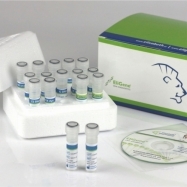EliGene® Tick-borne diseases RT
Intended use
EliGene® Tick-borne diseases RT kit is intended for DNA diagnostics of pathogenic species Borrelia spielmanii, Borrelia afzelii Borrelia garinii, Borrelia valaisiana, Borrelia burgdorferi sensu stricto, Anaplasma phagocytophilum and tick-borne encephalitis virus (TBEV) from isolated nucleic acid.
Principle of the method
This diagnostic kit is based on RealTime PCR method. In this kit primers and dual-labeled fluorescent probes for the detection of DNA are used.
Compatible instruments
The following list represents instruments on which the above mentioned kits were tested. Please contact us for compatibility with other instruments.
- Thermofisher Scientific: Quant Studio 5
- Bio-Rad: CFX96 Touch Real-Time PCR Detection System
- Bio Molecular Systems: MIC qPCR Cycler
Introduction
Lyme borreliosis is a disease caused by spirochete Borrelia burgdorferi. The detection of this bacterium could be made from any clinical material using the DNA diagnostics. There can be found five pathogenic species of Borrelia in Czech Republic: Borrelia spielmanii, B. afzelii, B. garinii, B. valaisiana and B. b. sensu stricto (Bonczek et al.,2015). EliGene® Tick-borne diseases RT Kit contains mix of primers and probes that are specific to all five mentioned Borrelia species with high sensitivity that allows detecting 1–10 Borrelia genomes in 5 µl of DNA sample. DNA diagnostics is useful in cases of Borrelia suspicion (anamnesis of tick or insect that suck the blood). For diagnostic purposes following clinical specimen are recommended:
a) whole EDTA blood (when the patient has a temperature and in acute period of the disease);
b) urine;
c) cerebrospinal fluid (in cases of neuroborreliosis);
d) synovial fluid;
e) tissue (skin biopsy).
Anaplasma phagocytophilum is obligate intracellular, gram-negative rickettsial organisms infecting human leukocytes. Anaplasma is transmitted to humans by tick bites primarily from the tick Ixodes scapularis and the tick Ixodes pacificus. It causes human granulocytic anaplasmosis (HGA) previously known as human granulocytic ehrlichiosis (HGE). Typical symptoms include fever, headache, chills, and muscle aches and they usually occur within 1-2 weeks of a tick bite. The epidemiology of this infection is very much like that of Lyme disease (caused by Borrelia burgdorferi) and babesiosis (caused primarily by Babesia microti), which all have the same tick vector.
Clinical material and recommended DNA isolation procedure
Blood, urine, CSF, synovial fluid, tissue
Manual: Quick-DNA/RNA Miniprep Plus Kit (Zymo Research)
Automatic: ZEPHYRUS Magneto (ELISABETH PHARMACON)
CE IVD
| Items | Ref. No. | Package | Price ex. VAT | VAT | |
|---|---|---|---|---|---|
| EliGene® Tick-borne diseases RT | 90091-RT | 50 reactions | On request | 21 % |
Instruction for use EliGene Tick-borne diseases RT
(published 19.09.2024, size 453.0 kB)
MSDS Tick-borne diseases Enzyme Mix EN
(published 12.05.2023, size 224.1 kB)
MSDS Tick-borne diseases IAC DNA EN
(published 12.05.2023, size 216.8 kB)
MSDS Tick-borne diseases PC DNA EN
(published 12.05.2023, size 210.3 kB)
MSDS Tick-borne diseases RT Mix EN
(published 12.05.2023, size 210.4 kB)


